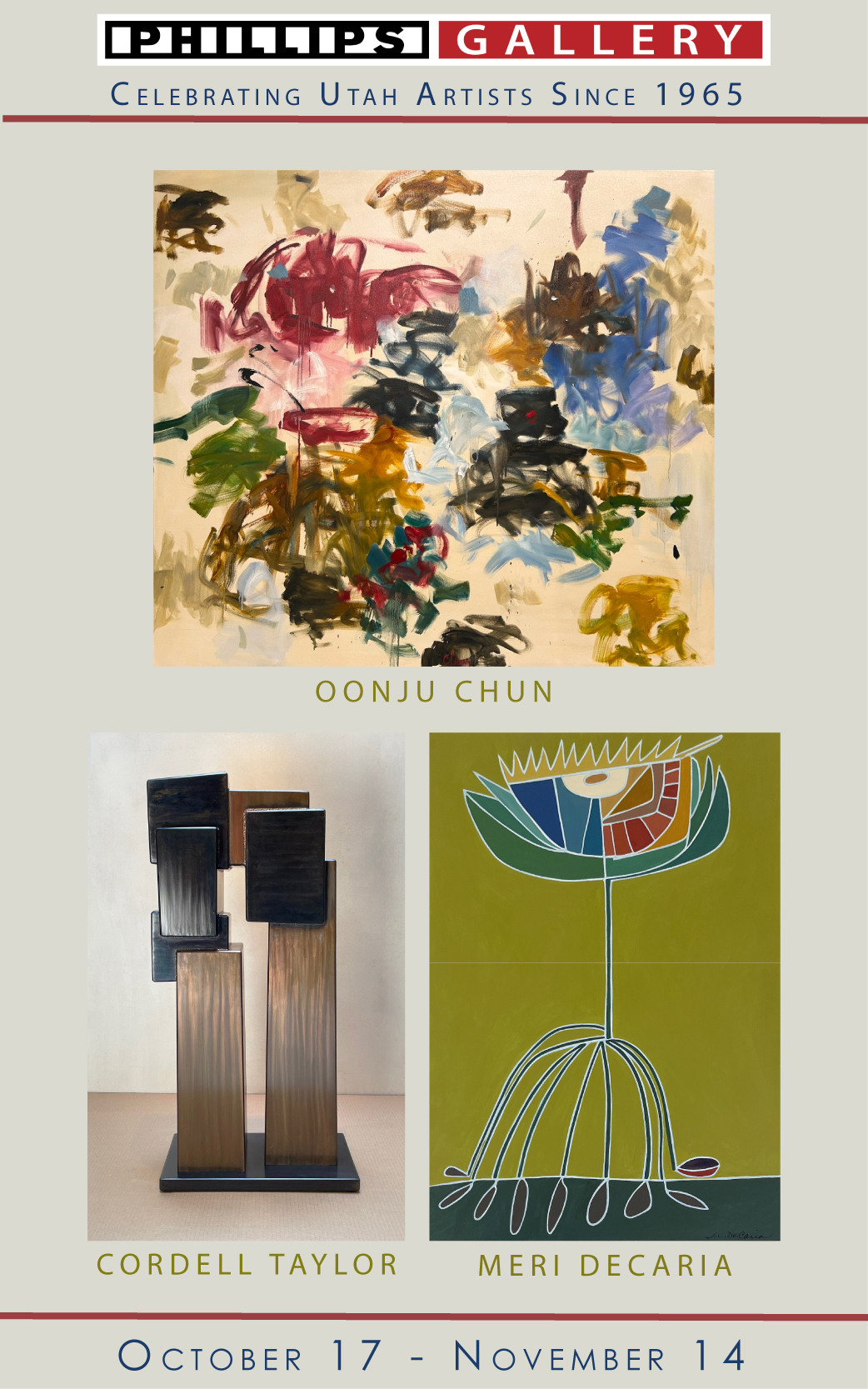
Installation view of Greg Newbold’s “New Year’s Day, Black Rock” and Nick Rees’ “Refinery” at the Springville Museum of Art. Courtesy of the Springville Museum of Art.
Though there is no set theme for the exhibit, the Spring Salon can create a strong contrast between and among works, causing interesting conversations, whether the pieces are hung near each other or in separate rooms.
Hanging Greg Newbold’s “New Year’s Day, Black Rock” and Nick Rees’ “Refinery” together brings the works into a striking dialogue. Above, there are the softer, colder colors of a daytime winter scene, and below there’s a dramatic orange sky cut into by industrial structures. These are just two pieces in the exhibit in a larger conversation of natural and industrial landscapes. Seeing them situated next to each other—despite how artists have historically been divided by either embracing or rejecting such modern structures in their imagery—makes them appear on equal footing. Where artists like the Pre-Raphaealites would reject painting a refinery, the jurors at the Salon see aesthetic value in the subject.
This theme of Modern Art history is a conversation we might have overheard a century ago: an anxiety about an increasingly industrial world versus the natural landscape. More current anxieties, about technology rather than industry, are expressed clearly in the titles of two works: “Bound By Screens: A Self-Portrait,” by Robert Fuerer, and Sara Luna’s “ChatGPT, Tell Me What to Do With This Pain” (discussed in Geoff Wiechert’s textile review of the Salon). Uncertainty about today’s technology could turn into a form of rejection for many artists, and we might see movements or trends to emulate art history as a point of opposition. On the other hand—to speculate about the future of art history while setting aside the question of whether this would be a good thing—I wonder if in the coming years screens and generative AI could carve out a space for aesthetic acceptance, similar to artists embracing industrial landscapes. I’ll leave it to your imagination to consider what any such acceptance by our cultural institutions might look like or what rules might or might not exist around it.

Robert Fuerer, “Bound By Screens,” oil on panel
- Michael J. Bingham, “Awaiting Fusion,” assemblage
- Sarah Schwieger, “In the Beginning,” assemblage
Another part of the Salon which stood out to me was its selection of assemblages. These works appear varied in their forms and motivations. Michael Bingham’s “Awaiting Fusion,” which features a two-dimensional and three-dimensional rooster, has been hung salon style on a wall of other artworks with birds as subjects. Bingham’s work stands out as it pushes away from the usual rectangular shape of pictures with its partially curved, fragmented pieces of framing around an ultimately three-dimensional work. Sarah Schwieger’s “In the Beginning,” though also protruding from the wall on which it is hung, offers a much more controlled feeling with a conventional rectangular frame. Such a decision, along with the fairly clean, mostly white look of the piece, and its small scale, may help in communicating the artist’s statement about God creating an orderly world out of the assembly of chaotic elements.

Byron Ramos, “Light Guide Me,” stone, wood, steel, 300- year-old Bible
Vincent Mattina and Byron Ramos eschew traditional frames altogether. Mattina’s “U of U (Uranium of Utah)” is a gritty piece which appears to be a cart with a propeller on the front, an American flag on the seat, and a tank presumably used for uranium mining. The lack of a frame makes the piece feel more like a found object which could have been picked up near a uranium mine, and its messiness leaves open more potential discomfort with the practices it highlights. The metal ring in Ramos’ “Light Guide Me” serves as a framing device, visually containing the central subjects of the work. This offers a more clearly positive and adventurous narrative. Its hanging geode acts as a focal point of the composition, which seems to symbolize something like the treasures and achievements of journeying across the seas or around the world. “U of U” as an object offers no such narrative about a clear goal, but makes space for viewers to wonder for themselves about the costs and benefits of uranium.
Lastly, R. Eric Lewis’ “Pilot’s Retirement Rocker” uses a found object for powerful self-reflection. The “Rocker” puts together an airplane seat and control stick for an adjustable chair that Lewis says is meant to maintain memories of his career as he retires. Though it would be wonderful if museum goers were allowed to sit in the Rocker, the memorialization of plane parts which are purely utilitarian under most circumstances can serve as a site of meaning for pilots and any visitors who ask themselves what objects they might similarly treat as a piece for a museum.
- Vincent Mattina “U of U (Uranium of Utah),” assemblage
- R. Eric Lewis, “Pilot’s Retirement Rocker,” metal
101st Annual Spring Salon, Springville Museum of Art, Springville, through July 5.
Categories: Exhibition Reviews | Visual Arts















It might be argued that “Spring” is a theme, set in place by its presence in the name. But I’d sooner say that I very much appreciate the way you look at art, and especially your ability to look upon two works at one time and see both. I hope you find your adventure in criticism as stimulating as I do.
Thank you! Glad you like the writing, it’s been fun!
Thank you for your review of the show. It’s always an honor to be included in the spring salon.
Excellent work David, you have a way of taking the reader along with you to these exhibits with your words.